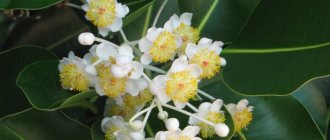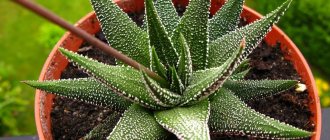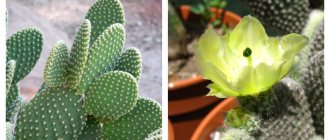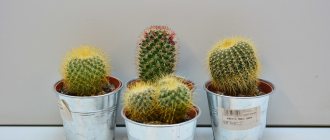Cacti are perennial flowering plants belonging to the Carnation family. The concept itself comes from the Greek word "kaktos", which was used to refer to unknown herbs and plants. The term "cactus" was first used in 1737 by scientist Carl Linnaeus as a shortened form of melocactus. The last term included all plants with thorns and sharp needles. The cactus (the plant’s homeland is North and South America) is a real “storehouse” of water and grows in various climatic conditions.
The first mentions of cacti
Before botany became a systematic science, many plants were mistakenly considered related. Various succulents were called cacti (from the Latin succulentus - “succulent”), and varieties that did not have thorns were classified as a different species. At the end of the 16th century. Flemish scientists presented a reliable image of one of the melon cacti. Following them, the botanist Carl Linnaeus first used the term Cactus (ancient Greek κάκτος - “thistle”) in relation to this plant, which gave the name to the whole family.
The cactus came to Europe after its first travels to the New World and soon became a popular exhibit in private botanical collections. Some pieces were worth twice as much in gold equivalent as they weighed.
Types of cacti
What types of cacti are there? There are several hundred species of cacti, which, in turn, are divided into varieties. The most popular include:
Mammillaria
This species has more than 150 varieties and is the most popular among gardeners. It is represented by medium and small sized cacti, which have a spherical or elongated cylindrical shape. Also, different species may have light spines, white or yellowish fluff, or no needles at all.
The name itself comes from the word “Nipple”. This unusual name is associated with the external feature of the plant: instead of ribs, it has bulges from which needles and flowers grow. Cactus flowers are usually small, funnel-shaped, pink, white or red with a dark center. The species is considered to have little flowering, mainly blooming in spring.
The most common types are:
- Mammillaria elongata: has a thin long stem, golden needles and small white flowers;
- Mammillaria Bocassi: has an elongated thick stem with a girth of up to 5 cm and small white flowers. The spines are arranged in groups: the central one is the longest, has a hooked shape and is brown in color, with several smaller white hair-like spines located around it;
- Mammillaria spiny: the stem is in the form of a ball, the spines are white or brown, thin and sharp. The flowers are pink, quite bright, growing at the top of the stem in a circle, forming a crown.
Rebutia
Another extremely common indoor species both in nature (mainly found in the mountains) and among gardeners. They have a ball shape and a fleshy stem, with a small depression at the top. The ribs are arranged in a spiral, the spines are short, white or yellowish in color. Typically, cacti of this type grow in groups.
Rebutia is distinguished by its abundant flowering. The white, red, purple flowers are quite large and noticeable, their diameter reaches 2.5 cm. A distinctive feature is the arrangement of the flowers: they grow not at the top, but at the base. Flowering occurs in April-June and lasts only 2 days.
One of the interesting varieties is tiny rebutia: it is a round cactus with a diameter of only 5 cm. It blooms with orange flowers in summer. The second popular variety is Rebutia senile: this is also a small cactus up to 8-10 cm in size.
Prickly pear
This is an unusual but rarely found species, which has more than 200 varieties. It is distinguished by a flat stem of an elongated oval shape. Often one stem seems to grow out of another. It has thin long spines, often sharp. It either grows upward or spreads along the ground. Some varieties are quite frost-resistant and can grow in gardens in southern regions. Many cacti of this species do not bloom at all at home. After flowering, fruits appear on them, which is why prickly pear is nicknamed “prickly pear.”
Which country is considered the birthplace of the plant?
Scientists believe that the homeland of the cactus is South America and the Caribbean islands, formerly called the West Indies. There it arose more than 30 million years ago in the form of a mesophytic dicotyledonous flower. By the time of the emergence of ancient Mesoamerican civilizations, he changed the exterior to one more resistant to hot climates.
From Aztec legends deciphered by ethnographers, it is known that prickly pear, called “nopal” by the indigenous inhabitants, was used in everyday life, eaten and was an object of cult, a symbol of the mercy of the gods. The plant is depicted on the modern coat of arms and flag of Mexico. To this day, in the markets of this country, the fruits of prickly pear, Echinocereus and Pilosodereus are sold as street food.
Necessary environment for growth
Although succulents are resistant to dry air and prolonged absence of moisture in the soil, they are difficult to tolerate drafts and hypothermia.
Considering the homeland of the cactus, do not allow the plants to fall into conditions where the air temperature is below +6°C.
In the summer, provide them with as much sunlight as possible, and in the fall, when the days become shorter, it is recommended to irradiate indoor cacti at home with an ultraviolet lamp for several hours a day.
In winter, cacti slow down their development and enter hibernation mode, during which their outer cover becomes thinner. Therefore, in the spring you should avoid direct sunlight on the plant for some time.
If it overheats, it must be sprayed with cool water. Otherwise, burns may occur on the skin.
How does a cactus adapt to its environment?
The high adaptation of the cactus to its habitat and to life in unfavorable conditions is determined by the structure of its root system. Many species have well-developed surface roots. This makes it possible to effectively use even a small amount of precipitation falling on the ground.
There are varieties of cacti whose roots are too thick. This also allows the plant to adapt to its environment, allowing the cactus to survive unfavorable conditions.
Features of caring for cacti
- A plastic pot with a retractable bottom would be perfect for replanting such a plant. The height of this container should exceed 15% of the length of the root.
- A comfortable environment for growing cacti is considered to be water, slightly acidic, loose soil and well-permeable air.
- Before planting the cactus in another pot, you need to stop watering for a few days - this will make it easier to remove the root from the soil. You will have to fill the new container 1/3 after the drainage layer with soil mixture. Next, you should carefully immerse the cactus roots into the container, sprinkling them with the rest of the soil. The root collar is sprinkled with river sand.
- The best place to place a cactus is on the sunny side of the room. It is bright light and fresh air that cacti need so much.
Soil for cactus
- Basically, cacti grow on slightly acidic and loose soils, the pH of which is 4.5-6.
- When planting a plant, it is worth thoroughly loosening the soil, because this ensures access of air and water to its roots.
- If it is not possible to purchase special soil for keeping a cactus, then you can use ordinary leaf soil for these purposes.
- It is advisable to add a small amount of rotted manure and coarse sand to the soil.
Proper watering
Cactus is a plant that is famous for intensive watering. What will be truly destructive for such a plant is frequent watering, which usually causes stagnation of water in pots.
Read also: Interesting facts about cherries, features, planting and care, application
In winter, the plant is watered rarely - no more than 2 times a month. For irrigation, it is advisable to use only soft rain or melt water. When watering a cactus with hard tap water, excess salts may accumulate at the base of the stem, which will negatively affect the development of the plant.
Comfortable temperature for a cactus
- The cactus is a heat-loving plant, but it is quite resistant to coolness. In winter, provided that the room temperature does not drop below 6-8 degrees Celsius, this plant feels great.
- Cacti are afraid of dry air and drafts. If it is possible to place this plant on the windowsill of a south window, then this is the best option. Lack of lighting can cause the cactus to wither, develop all kinds of diseases and deform the stem.
- The cactus blooms only when the room temperature is stable - 18-20 degrees. Regular ventilation of the room significantly speeds up the appearance of beautiful flowers on the cactus stem.
Is it possible to keep a cactus at home?
- You can, and sometimes even need to, keep a cactus in your house. In this case, it is worth choosing the right place for the location of the plant and providing rational care for it.
- Some scientific studies have proven that cacti are able to respond not only to the emotional state of the owner, but also to his voice. In this regard, regular communication with the plant will calm it down and allow it to exude only positive energy.
Ideal soil composition for indoor cactus
In order for the plant to produce flowers on time and not lose its attractive appearance, you need to choose the right components for the soil. The soil should allow moisture and air to pass through and give a slightly acidic reaction (not higher than 6.5 on the Ph scale). The soil must contain small pebbles, brick chips or coarse sand to provide drainage at the roots, otherwise putrefactive processes will begin.
A small amount of peat and greenhouse substrate will give the plant the necessary nutrition, rich in microelements.
The composition of the soil in which the cactus will grow properly must be balanced in each case differently:
- Ariocarpus, Astrophytum, Lophophora and other desert specimens require twice as much turf soil as leaf soil.
- Large cereus cacti need humus, which is added in a ratio of 1:4 to the amount of peat.
- Adult cacti should grow in denser soil, the main part should be greenhouse soil and clay-turf soil.
- Cacti with long spines need calcium supplements. Finely crushed eggshells will do.
Coal will prevent the roots from rotting, but it should be remembered that it alkalizes the soil. The admixture of clay in the soil blocks the excessive release of moisture from it.
You should not add too much humus or nitrogenous fertilizers - most cacti do not need growth stimulation.
Desert cacti
Desert cacti live in harsh conditions of lack of moisture, seasonal and daily temperature changes. Some species even tolerate negative temperatures. The stem of such cacti is thick, fleshy, without leaves, but with spines or hairs. The spines are modified bud scales, necessary mainly for protection.
IN THE PHOTO: Gymnocalycium
The stem performs several important functions. In most desert cacti, it serves as the main reservoir for water; in addition, photosynthesis occurs in the cells of the stem according to a very unusual mechanism. Cacti absorb carbon dioxide at night, and not during the day like other plants. Before the first rays of sunlight appear, CO2 is bound in plant cells, and during daylight hours it takes part in the synthesis of organic substances.
The stems of cacti have a ribbed structure or are covered with papillae. The ribs allow the plant to change volume depending on the amount of moisture, and also create shade that protects from overheating.
The structure of the root system of desert cacti is determined by adaptation to environmental conditions. Most have a shallow root system in order to absorb moisture from the outer layer of soil, wetted by occasional precipitation, fog or dew.
In the event of drought, the branched roots of the plant die off, leaving only the part necessary to remain in the soil. On the remaining roots, shiny cones form - waiting roots, with the help of which the plant quickly forms an extensive root system as soon as the soil becomes more moist. Some cacti have a pronounced main root, which serves to accumulate nutrients.
There are types of desert cacti that accumulate water not in the stem, but in the thickened main root. A number of other cacti have an even more interesting feature - their roots can contract and, during periods of drought, pull the plant’s body underground. Only during the rainy season do parts of the stem and flowers protrude slightly above the surface. These plants have a common species name meaning "underground".
Caring for Desert Cacti
In order for cacti to feel good at home and delight them with flowers, it is necessary to bring the conditions as close as possible to natural ones.
Basic information about wintering cacti:
- Most desert cacti require a period of rest, which occurs during the winter months. In the desert in winter there are relatively low temperatures and a complete lack of precipitation, so cacti hibernate, stopping their growth. During this period, plants are preparing to flower.
- Preparation for wintering begins in the fall by increasing the interval between waterings - first they switch to watering once a week, then once every 10 days, 2 weeks, a month.
- Watering a cactus at cool temperatures leads to the death of the plant; during wintering the plants are not watered.
- To create the necessary conditions, the cactus can be placed near a glass window, fenced off from a warm room with glass or film, or placed on a glazed balcony, if necessary, turning on the heater in severe frosts.
- There is no need to remove the plant from a dark place; it still needs light.
- Wintering temperature varies depending on the type of plant - from +5°C to +15°C.
- The transition to an active state, as well as preparation for wintering, should occur gradually. The plant begins to be watered in the spring, as soon as the weather becomes warmer and sunny. The first watering can be replaced by spraying. Gradually, the frequency of watering is increased - first the plant is watered once every two weeks, then once every 10 days, then once a week. At first, the plants are protected from direct sunlight.
Rules for watering desert cacti:
- Many people mistakenly believe that desert cacti can survive almost completely without water, but during the period of active growth, that is, in summer, they need moisture, like all plants. Therefore, water them when the top layer of soil dries out.
- Watering is necessary only for healthy plants; if the cactus is sick or recently transplanted, it cannot absorb water, it stagnates and causes rotting of the roots.
- Watering must be done in moderation - overwatering will lead to the death of the plant's roots, and lack of moisture will cause the cactus to stop growing.
- Desert cacti with sufficient watering do not need to be sprayed. Spray or wash plant stems only to remove dust, using warm water. Do not spray cactus species that have pubescence.
- Water all types of cacti with warm water, preferably purified or settled.
Soil and replanting of desert cacti:
- The soil needs to be loose and well permeable to air and water. Water must pass through the earthen lump on its own; the soil under the cacti cannot be artificially loosened so as not to damage the surface roots.
- The soil in deserts is rich in mineral salts; similar soil should be selected for growing cacti at home. There are special mixtures that meet all the necessary requirements. Cacti are not suitable for soils with a high content of organic matter, especially nitrogen.
- You can feed only healthy plants and only during the period of active growth (spring and summer).
- For cacti, only mineral fertilizers containing a minimum amount of nitrogen are used; it is better to use special mixtures. The main thing is not to overfeed the plant, otherwise you can spoil the soil and cause the death of the plant's roots.
- Desert cacti grow well in small pots that are almost the same size as the plant. Too much soil negatively affects the growth of the cactus and delays its flowering time.
- When replanting cacti, you must ensure that the root collar is not placed too deep in the soil - this can lead to the death of the plant. Instead of soil, the upper parts of the roots and the neck are sprinkled with fine crushed stone, which will hold the plant and allow moisture to pass through well, so that water does not stagnate near places prone to rotting.
- A common mistake is watering a cactus immediately after transplanting; this should never be done. The first watering is carried out only after the plant has rooted.
Temperature and light:
- Desert cacti love the sun very much, so they should be placed on the sunny side.
- Plants tolerate fresh air well; in summer they can be kept on the balcony; daily temperature changes have a beneficial effect on the development and growth of cacti.
- The temperature of desert cacti varies depending on the season.
Evolution of species
The predecessors of the cactus arose in the era of a single continent, when the climate in the area of origin was mild and humid. They had leaves that later transformed into needles. The split of the continent led to a shift in territory, and the habitat changed to a more severe one, with prolonged drought and heat.
Leaves became unprofitable under these conditions because they evaporated too much water. During evolution, they began to thicken and become covered with a protective shell, under which they stored moisture. In habitats with a large number of animals, the spines lengthened and became hard; in less populated areas they remained soft to better absorb dew.
Routes to Russia
After Columbus's first voyage around the world, active exploration of the lands of the New World began. In addition to spices, hunting trophies and luxury goods, little-studied plant species, including cacti, began to arrive in Europe.
With the development of apothecary business under Peter I, exotic succulents began to be imported to Russia.
Doctors invited from Europe were by that time aware of the medicinal properties of aloe and used it in their practice. Following these plants, prickly pears and euphorbias entered the Apothecary Garden established by the emperor by the middle of the 18th century. From the records of the Medical Chancellery it is known that some of them were sold to private individuals.
In subsequent centuries, cacti were also imported by Russian travelers exploring the lands of South America. Thus, the Russian ethnographer G. Langsdorff and botanist L. Riedel, who traveled through the Amazon, transported several thousand living specimens to their homeland.
Current distribution area
The usual habitat of most species of cacti is North and South America, but in Central it is practically absent. Argentina, Paraguay, Uruguay, Bolivia, Chile and Peru, the Caribbean countries and the humid regions of southern Brazil are richest in different species. From their places of origin, they were brought by humans to other continents and islands, where the climate allowed some species to take root - these are Africa, Sri Lanka, Zanzibar and Madagascar.
Prickly pear in Eurasia has developed resistance to snow; it can be found in Greece, Turkmenistan and the Krasnodar Territory, in the North Caucasus. Considering the unpretentiousness of this species and its ability to tolerate frost, it can be assumed that prickly pear will continue to spread throughout Russia.
Features of cacti
America is the birthplace of cacti. In the wild, cacti can grow to significant sizes. Desert cacti thrive in the harsh semi-desert conditions of Argentina, Chile, Mexico, Peru and Bolivia. Forest cacti can be found in natural conditions in tropical jungles. Desert and forest species of cacti have significant differences, and in this regard, how to care for a cactus is determined by its type.
How to care for cacti // How to water cacti? // ALL cacti are blooming











